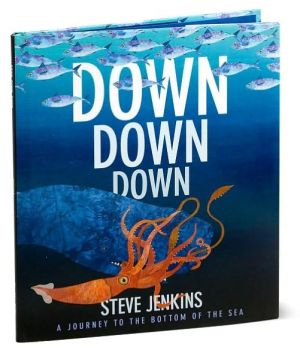Down, Down, Down: A Journey to the Bottom of the Sea
Caldecott Honor–winning Steve Jenkins provides a top-to-bottom look at the ocean, from birds and waves to thermal vents and ooze.\ Half the earth’s surface is covered by water more than a mile deep, but most of this watery world is a mystery to us. In fact, more people have stood on the surface of the moon than have visited the deepest spot in the ocean.\ Come along as we travel\ down,\ down,\ down,\ from the surface to the bottom of the sea.\ Along the way you can see jellyfish that flash...
Search in google:
Caldecott Honor–winning Steve Jenkins provides a top-to-bottom look at the ocean, from birds and waves to thermal vents and ooze.Half the earth’s surface is covered by water more than a mile deep, but most of this watery world is a mystery to us. In fact, more people have stood on the surface of the moon than have visited the deepest spot in the ocean. Come along as we traveldown,down,down,from the surface to the bottom of the sea. Along the way you can see jellyfish that flash like a neon sign, creatures with teeth so big, they can’t close their mouths, and even a squid as long as a bus, which battles to the death with a sperm whale, the largest predator on earth. It’ll be a journey you won’t soon forget!The New York Times - Lawrence DownesFor capturing the scale and biological richness of the ocean in a picture book, it seems hard to do better than Down, Down, Down, by Steve Jenkins…Through the almost magical use of cut paper, Jenkins takes the reader on a voyage from the surface to the sunlit shallows to the very bottom of the sea.
\ From the Publisher"In this plunge into the deep, Jenkins displays his usual keen awareness of what is fascinating about biology and imparts it without sensationalism—the facts speak for themselves . . Sophisticated cut- and torn-paper collage-work fit the alien qualities of the subjects well; it’s equally at home capturing the tiered needlepoints of lizardfish teeth as it isdelivering an impressive and illuminating display of bioluminescence."—Booklist\ \ “Browsers will be delighted by the variety of species, shown in their appropriate colors although not to scale. Backmatter provides some information about the animals pictured, including sizes compared to a human body or hand, although the bibliography does not seem to include the sources used for those facts. Once again, Jenkins provides an almost irresistible entry into our natural world for the youngest readers.”—Kirkus Reviews\ \ "Jenkins takes his signature collage to the oceans, sinking readers from the surface of the Pacific Ocean down nearly 11,000 meters to the bottom of the Marianas Trench. His style works well here: with passage into each zone (from the surface to the sunlit zone to the twilight zone, etc.), the blue backgrounds shade darker and murkier, which allows the intricate cut-paper animal illustrations to pop."—Horn Book\ \ "Depicted in Jenkins's signature handsome collages, the denizens of each level swim against ever-darkening backgrounds ranging from sunny blue to deepest black . . . The bold views tend to emphasize the weirdness of these little-known species, but the repeated message that humans have much to explore and learn in the deeper ocean is intriguing and inviting."—School Library Journal\ \ "Through the almost magical use of cut paper, Jenkins takes the reader on a voyage from the surface to the sunlit shallows to the very bottom of the sea."—New York Times Book Review\ \ “A must for any geography or natural history collection, this will be a great preparation for an aquarium visit or any discussion of ecology. More than that, however, it manages to convey the fact that most of our world is very, very different from what we experience, and that there may be nothing so strange and wonderful as our own planetary home.”—The Bulletin, starred review\ \ \ \ \ Lawrence DownesFor capturing the scale and biological richness of the ocean in a picture book, it seems hard to do better than Down, Down, Down, by Steve Jenkins…Through the almost magical use of cut paper, Jenkins takes the reader on a voyage from the surface to the sunlit shallows to the very bottom of the sea.\ —The New York Times\ \ \ Children's Literature\ - Ken Marantz and Sylvia Marantz\ Jenkins uses his remarkably realistic cut and torn paper collages to depict in detail many of the creatures that inhabit the ocean. Down the right side of each double page he has a narrow dark line representing the Pacific Ocean from the top, surface level down to the deepest spot, 35,838 feet. As we turn the pages, we descend, meeting on the way the creatures of that level along with a paragraph of information about that part of the sea. In the sunlit zone swim the green sea turtle and the sailfish. The vampire squid joins the hatchet fish in the twilight zone at 1,640 feet, while the giant squid encounters a sperm whale in the dark zone. On five additional pages, Jenkins revisits each double page in miniature, numbering the characters shown there to add factual information about each. He includes a human hand to give an idea of the actual scale. Jenkins ably demonstrates again here, as he has in the past, how to combine useful information with esthetically moving images. Reviewer: Ken Marantz and Sylvia Marantz\ \ \ \ \ School Library JournalGr 3-6\ Starting at the surface of the Pacific Ocean, Jenkins introduces some of the animals that inhabit descending layers of water all the way down to the Marianas Trench. At nearly 36,000 feet, this zone has been visited only once, by human passengers of a research vessel. Depicted in Jenkins's signature handsome collages, the denizens of each level swim against ever-darkening backgrounds ranging from sunny blue to deepest black. Each double-page segment begins with a paragraph or two explaining the growing degree of darkness, cold, and pressure, and how all of these affect the lives of the resident creatures. A bar running down the far right of each scene indicates depth. Usually three or four animals-whales, fish, worms, and more-are featured. Sometimes colorful or luminescent and often toothy, they are both familiar and strange. In some views, the animals are relative in size, but in others, those that are actually quite different in scale appear to be similar. At the end of the book, an added paragraph about each scene takes up the matter of size. Here length is stated, and silhouettes compare each creature to either an adult human's hand or a full body. The bold views tend to emphasize the weirdness of these little-known species, but the repeated message that humans have much to explore and learn in the deeper ocean is intriguing and inviting. This is a good complement to Sneed B. Collard's The Deep-Sea Floor (Charlesbridge, 2003), which introduces some of the same animals and offers more information about recent exploration.-Margaret Bush, Simmons College, Boston\ \ \ \ \ \ Kirkus ReviewsFrom above the surface to the bottom of the deepest sea canyon, unusual creatures inhabit every level of our oceans, even those seemingly hostile to life. In this intriguing introduction, Jenkins explores the Pacific, gradually descending to its depths (shown by a scale along the right hand side of each double-page spread). His signature cut-paper illustrations show more than 50 creatures, from the albatross in the air to the flatfish living at the bottom of the Mariana Trench. Along the way he introduces such oddities as a three-foot comb jelly called a Venus's girdle, a glowing siphonophore colony and a hairy angler with her parasitic mate. Browsers will be delighted by the variety of species, shown in their appropriate colors although not to scale. Backmatter provides some information about the animals pictured, including sizes compared to a human body or hand, although the bibliography does not seem to include the sources used for those facts. Once again, Jenkins provides an almost irresistible entry into our natural world for the youngest readers. (Informational picture book. 5-8)\ \








